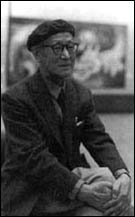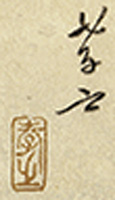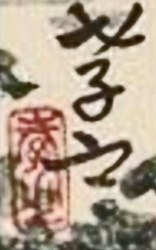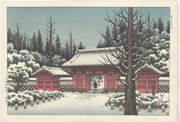Prints in Collection
Spring Snow at Kamikochi 1932 IHL Cat. #74 | 1965 IHL Cat. #29 |
Biographical Data
Biography
Itō Takashi 伊藤孝之 (1894-1982)
Sources: Hanga.com website http://www.hanga.com/bio.cfm?ID=8; Japanese Wood-block Prints, Shizuya Fujikake, Japan Travel Bureau, 1938, p. 88, 89; Printed to Perfection Twentieth-century Japanese Prints from the Robert O. Muller Collection, Joan B. Mirviss, et. al., Smithsonian Gallery and Hotei Publishing, 2004, p. 91.
Many of Takashi's early woodblock prints were only printed in one or two colors, because he was still experimenting with composition and design. These prints were probably not widely distributed. In 1923, a devastating earthquake struck Tokyo destroying the blocks for Takashi's early prints. However, at least one print, Ferry at Odai, Tokyo, was recarved by Watanabe's craftsmen and reprinted for many years afterward.
Many of Takashi's prints are idealistic images that emphasize the beauty of the unspoiled Japanese landscape. He enjoyed depicting dramatic seasonal and weather phenomena and often used bright, almost surreal colors to emphasize these changes. Occasionally people are part of his designs, but they are always incidental, solitary figures. A typical print, Takegawa River at Dawn, shows man living in harmony with nature. Takashi's prints evoke the Japan of old and represent the height of romantic shin hanga landscapes.
Watanabe's Comment on the Artist
Source: Printed to Perfection Twentieth-century Japanese Prints from the Robert O. Muller Collection, Joan B. Mirviss, et. al., Smithsonian Gallery and Hotei Publishing, 2004, p. 91.The biography of the artist's life included in the 1936 Watanabe sale catalogue is somewhat cryptic. Watanabe describes Ito as an artist who experimented frequently with printing and overprinting, and that he also carved one design himself entitled Sinking Sun which illustrated the courtyard of Tokyo Imperial University (present-day University of Tokyo.) Sinking Sun was apparently not published by Watanabe and was distributed by Ito to members of the Edo-Picture Appreciation Society. Watanabe also states that at the time of the Great Kanto Earthquake in September 1923 a number of trial prints by Ito, done in conjunction with Watanabe's printers, were in progress. They were subsequently abandoned due to the destruction of his shop premises.
Comment on Artist's Style
Source: Artelino website article by Dieter Wanczura http://www.artelino.com/articles/ito_takashi.asp
The style in which Takashi Ito prints were created looks more like brush stroke paintings than typical Japanese woodblock prints. The prints have a lot of color gradation instead of plain even color areas that are so typical for classical Japanese ukiyo-e. It required highly skilled carvers and printers to produce Takashi Ito prints. The Watanabe studio had these excellent artisans!
The style in which Takashi Ito prints were created looks more like brush stroke paintings than typical Japanese woodblock prints. The prints have a lot of color gradation instead of plain even color areas that are so typical for classical Japanese ukiyo-e. It required highly skilled carvers and printers to produce Takashi Ito prints. The Watanabe studio had these excellent artisans!
Sampling of Seals and Signatures
 signed 孝之 (Takashi) sealed 孝之 (Takashi) |  signed 孝之 (Takashi) signed 孝之 (Takashi)sealed 孝之 (Takashi) |  signed 孝之 (Takashi) seal 伊藤孝之 (Itō Takashi) |  signed 孝之 (Takashi) signed 孝之 (Takashi)seal 伊藤孝之 (Itō Takashi) |

